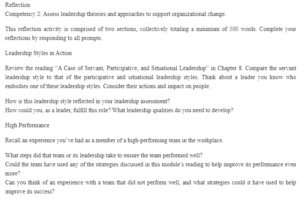Leadership Styles in Action
Servant leadership entails service to the followers. Servant leaders prioritize the needs of their followers and engage them in the process of fulfillment. Nelson Mandela is a perfect example of a servant leader. Nelson Mandela was South Africa’s first black president. Nelson Mandela demonstrated kindness and empathy to all citizens regardless of color during his life. Due to his staunch belief in democracy and freedom of the country’s citizens, Mandela underwent pain and suffering in the form of imprisonment. In his statement, Mandela reiterated his readiness to die for the South African citizens. He consciously fought for the equity of all individuals as well as justice (Manning & Curtis, 2012). His style of leadership matches the characteristics and behaviors of servant leaders.
As a leader, I would require additional training in servant leadership to fulfill such a role. First, I would need training in conflict navigation due to the high likelihood of conflict. The natural existence of disagreements demands that a leader turn confrontation into collaboration. Situations that involve criticism and arguments should be viewed as learning opportunities. The second aspect that I need to learn is the ability to take time for myself, which should allow me to recharge. As a leader, it can be exhausting to address the needs of the followers. Since it is physically and emotionally draining, it is essential to learn when to take time and recharge to serve the followers best. Finally, I need to undergo training on how to be an active listener as well as the delegation of roles. Active listening is essential for fostering mutual understanding. The board provides followers with a chance to improve their performance (Kruse, 2021).
As a high-performing team member, I observed that the leaders ensured that we all accessed training that was relevant to the assigned roles and responsibilities. Training activities provided updated information on various aspects of our work. We gained diverse skills and knowledge that consistently improved our ability and confidence to perform. In addition, the team members took time to interact and bond over non-work activities. These discussions that are not related to work fostered deeper and more authentic connections with each other. The friendships that arise from these interactions improve the teamwork in a group (Friedman, 2021).
My experience in a team that did not perform well was different. The leaders did not use recognition as a form of motivation. The team members did not feel appreciated or valued because their efforts were not acknowledged. Such a team could also use appreciation from the managers and their peers. Finally, the team could have used more alignment toward a specific direction. Such alignment can only be created through a shared vision and understanding of the current mission. A common goal allows team members to work towards the same outcome. It also provides a clear picture of the company’s purpose and its connection or influence on the individuals (Friedman, 2021). Understanding the mission allows individuals to connect these to their objectives, which increases the likelihood of achievement.
References
Friedman, R. (2021). 5 Things High-Performing Teams Do Differently. Harvard Business Review.
Kruse, K. (2021). Servant Leadership: Definition, Examples, Characteristics.
Manning, G., & Curtis, K. (2012). The Art of Leadership. McGraw-Hill Irwin.
ORDER A PLAGIARISM-FREE PAPER HERE
We’ll write everything from scratch
Question

Leadership Styles in Action
Reflection
Competency 2: Assess leadership theories and approaches to support organizational change.
This reflection activity is comprised of two sections, collectively totaling a minimum of 500 words. Complete your reflections by responding to all prompts.
Leadership Styles in Action
Review the reading “A Case of Servant, Participative, and Situational Leadership” in Chapter 8. Compare the servant leadership style to that of the participative and situational leadership styles. Think about a leader you know who embodies one of these leadership styles. Consider their actions and impact on people.
How is this leadership style reflected in your leadership assessment?
How could you, as a leader, fulfill this role? What leadership qualities do you need to develop?
High Performance
Recall an experience you’ve had as a member of a high-performing team in the workplace.
What steps did that team or its leadership take to ensure the team performed well?
Could the team have used any of the strategies discussed in this module’s reading to help improve its performance even more?
Can you think of an experience with a team that did not perform well, and what strategies could it have used to help improve its success?


